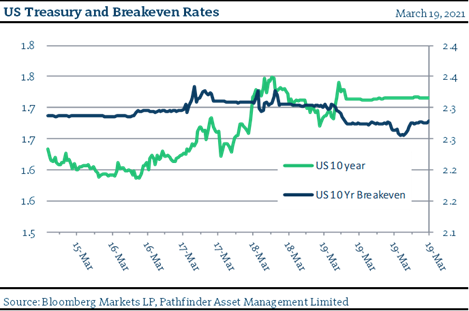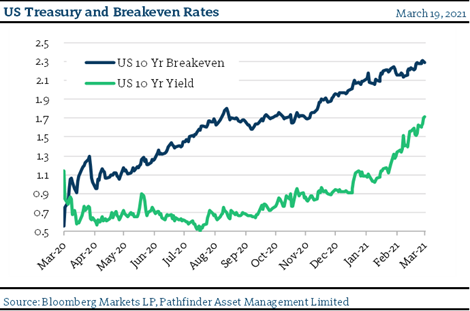Inflation Strategy
We have been writing about our views and observations on inflation over a number of recent Outlooks. We have noted for the reader that there is a link between increased inflation expectations, increased treasury yields and the negative implications for valuation of long-dated assets (like equities or very long-term bonds). In this case, a significant portion of the future cash flows from the asset will be valued less in the future if there is an uncontrolled increase of inflation. The implication for our portfolios is how we position the assets that we own in relation to inflation expectations. We noted that many of the monetary and fiscal policies put forth by central banks from around the world, as well as current business conditions, are inflationary but we also noted that we believed there was substantial employment slack that would act as a substantial buffer.
- Figure 1 presents price data for the last week for the treasury market and breakeven rates, which are used to estimate inflation. We believe that the observed volatility comes from technical changes with banking regulations that are forcing large US banks to sell their inventory of treasuries and not a very recent material change in inflation expectations. As you can see breakeven rates are somewhat flat.

- Figure 2 presents treasury yields and inflation expectations for the past year. Since January, there has been significant volatility with the long bond, which has translated into equity volatility, particularly for technology stocks. Inflation expectations, on the other hand, had increased on what we would consider to be a gradual and measure basis.

“This means that” while volatility in certain sectors of the stock market has increased, we would view any substantial drawdown an opportunity to add to good quality companies with substantial earnings power. We would prefer to have our capital in equities than cash of fixed income.
National Instrument 31-103 requires registered firms to disclose information that a reasonable investor would expect to know, including any material conflicts with the firm or its representatives. Doug Johnson and/or Pathfinder Asset Management Limited are an insider of companies periodically mentioned in this report. Please visit www.paml.ca for full disclosures.
*All returns are time weighted and net of investment management fees. Returns from the Pathfinder Partners’ Fund and Pathfinder Real Fund are presented based on the masters series of each fund. The Pathfinder North American Equity Pportfolio and The Pathfinder North American Income Portfolio are live accounts. These are actual accounts owned by the Pathfinder Chairman (Equity) and client (High Income) which contain no legacy positions, cash flows or other Pathfinder investment mandates or products. Monthly inception dates for each fund and portfolio are as follows: Pathfinder North American Equity Portfolio (January 2011), Pathfinder North American High-Income Portfolio (October 2012) Pathfinder Partners’ Fund (April 2011), Pathfinder Real Fund (April, 2013), and Pathfinder International Fund (November 2014).
Pathfinder Asset Management Limited (PAML) and its affiliates may collectively beneficially own in excess of 10% of one or more classes of the issued and outstanding equity securities mentioned in this newsletter. This publication is intended only to convey information. It is not to be construed as an investment guide or as an offer or solicitation of an offer to buy or sell any of the securities mentioned in it. The author has taken all usual and reasonable precautions to determine that the information contained in this publication has been obtained from sources believed to be reliable and that the procedures used to summarize and analyze such information are based on approved practices and principles in the investment industry. However, the market forces underlying investment value are subject to sudden and dramatic changes and data availability varies from one moment to the next. Consequently, neither the author nor PAML can make any warranty as to the accuracy or completeness of information, analysis or views contained in this publication or their usefulness or suitability in any particular circumstance. You should not undertake any investment or portfolio assessment or other transaction on the basis of this publication, but should first consult your portfolio manager, who can assess all relevant particulars of any proposed investment or transaction. PAML and the author accept no liability of any kind whatsoever or any damages or losses incurred by you as a result of reliance upon or use of this publication.